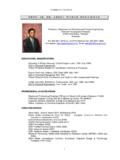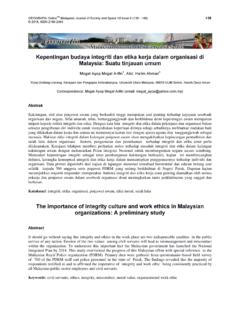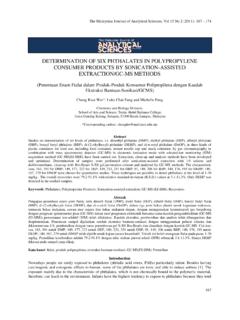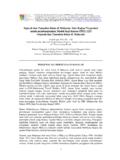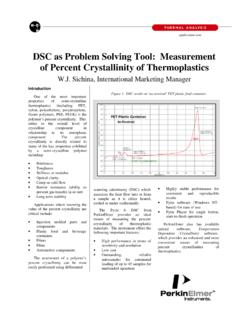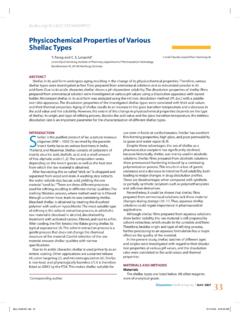Transcription of UPTAKE OF HEAVY METAL IONS BY CHELATING ION …
1 The Malaysian Journal of Analytical Sciences, Vol 16 No 2 (2012): 117 - 133. UPTAKE OF HEAVY METAL IONS BY CHELATING ION- exchange . RESIN derived FROM P- hydroxybenzoic ACID-FORMALDEHYDE- RESORCINOL: SYNTHESIS, CHARACTERIZATION AND. SORPTIONDYNAMICS. (Pengambilan Ion Logam Berat oleh Resin Penukar Ion Terbitan Asid p-Hidroksibenzoik- Formaldehid-Resorsinol: Sintesis, Pencirian dan Dinamik Erapan). Riddhish R. Bhatt1, Bhavna A. Shah1* and Ajay V. Shah2. 1. Department of Chemistry, Veer Narmad South Gujarat University, Surat-7, Guj., India. 2. Department of Chemistry, Polytechnic, Vidhyabharti Trust, Umrakh, Bardoli, Guj., India *Corresponding author: Abstract CHELATING ion- exchange resin (pHFR) has been synthesized by condensing p- hydroxybenzoic acid with formaldehyde employing resorcinol as cross linking agent at 80 5 oC using DMF as a solvent.
2 The resin was characterized by elemental analysis, FTIR, 1. H-NMR and XRD. The thermal analysis (TGA, DTA and DTG) was done at the heating rate of 10 oC/min in N2 atmosphere. The morphology of the resin was studied by optical photographs and scanning electron micrographs (SEM) at different magnifications. The physico-chemical properties have been studied. The UPTAKE behaviour of various METAL ions viz. Ni(II), Cu(II), Zn(II), Cd(II) and Pb(II) towards pHFR resin have been studied depending on contact time, pH, METAL ion concentration and temperature. The maximum UPTAKE capacity for Ni(II), Cu(II), Zn(II), Cd(II) and Pb(II) are found , , , and mmol/g respectively. The selectivity order is: Cu(II)>Pb(II)>Zn(II)>Cd(II)>Ni(II).
3 The intra-particle diffusion rate constant (Kid) and external diffusion rate constant (Ks) are calculated by Saphn-Schlunder and Weber-Morris models respectively. Equilibrium adsorption data were analyzed by Langmuir and Freundlich equations. The adsorption process follows first order kinetics and specific rate constant Kr was obtained by the application of Lagergan equation. Thermodynamic parameters viz. Go, So and Ho have also been calculated for the METAL -resin systems. Keywords: CHELATING resin, thermal study, SEM, Thermodynamics, optical photograph, kinetics Abstrak Satu resin penukar ion kelat (pHFR) telah disintesis melalui kondensasi asid p-hidroksibenzoik dengan formaldehid menggunakan resorsinol sebagai agen taut silang pada suhu 80 5 oC dan DMF sebagai pelarut.
4 Resin ini telah diciri menggunakan analisis unsur, FTIR, 1H-NMR dan XRD. Analisis terma (TGA, DTA dan DTG) telah dilakukan pada kadar pemanasan 10oC/min dalam atmosfera N2. Morfologi resin telah dikaji menggunakan fotograf optik dan mikrograf electron imbasan (SEM) pada pelbagai pembesaran. Sifat fiziko-kimia telah juga dikaji. Perlakuan pengambilan pelbagai ion logam seperti Ni(II), Cu(II), Zn(II), Cd(II) dan Pb(II) terhadap resin pHFR telah dikaji pada pelbagai masa sentuhan, pH, kepekatan ion logam dan suhu. Muatan maksimum pengambilan bagi Ni(II), Cu(II), Zn(II), Cd(II) dan Pb(II), masing-masing ialah , , , mmol/g. Tertib selektiviti ialah : Cu(II)>Pb(II)>Zn(II)>Cd(II)>Ni(II). Pemalar resapan intra-zarah (Kid) dan pemalar kadar resapan luaran (Ks) dikira menggunakan model Saphn-Schlunder dan Weber-Morris.
5 Data jerapan keseimbangan dianalisis berdasarkan persamaan Langmuir dan Freundlich. Proses jerapan didapati mengikut kinetik tertib satu dan pemalar kadar tentu Kr didapati melalui persamaan Lagergan. Parameter termodinamik seperti Go, So dan Ho telah juga dikira bagi sistem logam-resin yang dikaji. Kata kunci: Resin kelat, kajian terma, SEM, termodinamik, fotograf optik, kinetik 117. Bhatt et al: UPTAKE OF HEAVY METAL IONS BY CHELATING ION- exchange RESIN derived . FROM P- hydroxybenzoic ACID-FORMALDEHYDE-RESORCINOL: SYNTHESIS, CHARACTERIZATION AND SORPTIONDYNAMICS. Introduction Removal, separation and enrichment of trace metals in aqueous solutions play an important role for the analysis of wastewaters, industrial and geological samples.
6 Many separation techniques such as solvent extraction and ion- exchange chromatography have been applied for this purpose. Ion exchange is a popular method owing to its applicability to both pre-concentration and separation. The ion- exchange resin from salicylic acid and formaldehyde was derived by DeGeiso et al [1] in 1962. They have studied the ion exchange capacity and selectivity of salicylic acid-formaldehyde copolymer with Fe3+, UO22+ ions as a function of pH. Patel et al [2, 3] have prepared the terpolymer of salicylic acid/p-hydroxy benzoic acid and thiourea with trioxane in the presence of acid catalyst with different molar proportions of monomers. Shah et al have been synthesized CHELATING resin from o-substituted benzoic acid and studied its ion- exchange properties [4].
7 The micro-wave assisted synthesized phenolic- formaldehyde polymers were prepared and their ion exchange properties towards the HEAVY METAL ions were studied using a static batch equilibrium technique at 25 oC as a function of contact time, pH and concentration [5]. The sorption capacity of salicylic acid-formaldehyde condensate towards Al(III), Cu(II), Ni(II), Zn(II) and Co(II) were studied. The resin was found selective for Cu(II) ion with highest exchange capacity of mmol/g [6]. Kapadia et al [7-9] prepared ion exchange resins from various phenolic derivatives like salicylic acid, gallic acid, - resorcylic acid, anthranilic acid, 8-hydroxyquinoline and hydroquinone using DMF as a solvent. They have studied their anion as well as cation exchange properties towards various METAL ions.
8 Mubarak and coworkers [10] have studied the chelation behavior of the phenolic-formaldehyde polymers towards the trivalent lanthanide METAL ions such as La3+, Nd3+, Sm3+, Gd3+ and Tb3+ by a static batch equilibrium technique at 25 oC as a function of contact time, pH and concentration. Samal et al [11] prepared resins from the diazonium salt of aniline with phenol/resorcinol coupled with formaldehyde in alkaline medium. They have studied the UPTAKE behavior of alkali and alkaline earth METAL ions by the resin. The optimum conditions for effective separation of Cu 2+ from UO22+ were also determined. Recently, in 2006, Burgeson et al [12] evaluated resorcinol-formaldehyde resin for cesium removal and cesium elution characteristics.
9 A new spherical form of resorcinol-formaldehyde resin [13] was also tested for efficiency of cesium removal from the complex mixture of radioisotopic liquid wastes. Resin from salicylic acid and formaldehyde with resorcinol [14] in DMF media has also been prepared and studied for its chelation ion- exchange properties. Shah et a [15] synthesized ion- exchange resin from anthranilic acid and formaldehyde with resorcinol in DMF media. They have separated transition and post transition METAL ions from synthetic binary mixtures using tartaric acid as eluting agent. So far no resin based on p-hydroxy benzoic acid-formaldehyde-resorcinol in DMF media has been reported with its morphology and thermal characteristics along with its kinetic and thermodynamic parameters.
10 As industrial effluents are often rich in transition and post transition METAL ions, removal and recovery of these metals is an important task for industries. In this paper, synthesis, characterization and different physico-chemical and chelation properties of the resin are reported along with its thermal and morphological studies. Various diffusion models and isotherm equations were employed to analyze the sorption data. Materials and Methods Materials and Reagents Analytical grade chemicals such as p- hydroxybenzoic acid (Ranbaxy fine chemicals Nagar), formaldehyde (37%) (Qualigens fine chemicals, Mumbai) and catechole (SRL Mumbai, extra pure) used as received without further purification. Solutions of acids and alkalies were prepared by dissolving appropriate amount of the particular compound in double distilled water and standardized by the literature methods [16].


